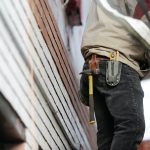What is a slate roof?
On a sloping roof, a slate roof is made up of overlapping slate roof tiles that are firmly bonded to a solid substrate or roof deck. A slate roof, sometimes known as a hundred-year roof, may survive for 100 years or longer if correctly erected. The installation of slate tile roofing is a highly technical subject and it necessitates the hiring of a contractor that has worked with and installed slate roof tiles on a variety of projects. Slate tile roofing systems may be found on a wide range of residential, commercial, and historical sites, including resorts, museums, churches, and educational institutions.
What are slate roof tiles made of?
Slate roof tiles are a natural roofing material consisting of metamorphic rock, a type of hard rock. Deep under the ground, heat and pressure change minerals, clay, volcanic materials, and other substances into very thick rock. Slate roof tile colors like black and grey suggest a high carbon content, while minerals like hematite and iron give some slate colors their colors. Natural slate is available in a variety of colors, including blue, purple, red, green, brown, tan, and others. Slate roof tiles originally emerged in the United States in the northeastern region of the country, when huge slate deposits were discovered.
Due to the appeal of slate roofing’s look, there are a variety of “fake” slate roof tile possibilities. Clay, composite, rubber, asphalt shingles, and other materials were used to simulate the appearance of slate. However, you should familiarize yourself with the types of materials utilized in the manufacture of any synthetic slate roof tile items you are contemplating. While there are several outstanding synthetic slate roofing materials on the market, nothing beats the genuine article. Let us start by looking at some of the most frequent materials used to make slate roof tiles.
- Natural Slate Roof Tiles
Natural slate roof tiles come from a number of different slate quarries all around the world. Some slate roofs have a single tile color that runs the length of the roof, while others incorporate slate from several sources to produce a lovely blend of colors and textures. Depending on the source and how it is treated, natural slate comes in a variety of forms, thicknesses, and hues. Slate is collected from open quarries or slate mining tunnels.
Slate roof tiles can be found in abundance all over the world, including Spain, Italy, Germany, the United Kingdom, and Brazil. Natural slate has been commercially quarried in the United States since the early 1700s, beginning in Pennsylvania. Vermont, New York, and Virginia are among the other major slate-producing states in the United States. The Glendyne Quarry in Quebec, Canada, is the largest roofing slate producer in North America.
Advantages of Natural Slates
- Life expectancy is really high (80-100 years).
- Looks natural
- Storm-proof.
- Minimal or no upkeep is required (material is barely porous).
- Temperature fluctuations are well shielded.
Disadvantages of Natural Slates
- When compared to other types of roofing, it is more expensive.
- It’s conceivable that there will be flaws in the quality or execution (this is inherent to a natural product).
Costs of Natural Stones Slate Tiles
Natural slate tiles are composed of natural stone, one of the most expensive roofing materials on the market. Natural slate can be hard or soft, and comes in a variety of colors, shapes, and sizes. It has a rich feel to it. For each roof size, you may anticipate paying more for a bigger roof than for a smaller roof and less for synthetic slate shingles than for genuine slate shingles. The biggest disadvantage of natural slate tiles is their weight, thus homes built with them must be structurally stable enough to support the shingles’ weight. Natural slate tiles range in price from $10 to $30 per square foot.
- Composite Slate Roof Tiles
Some of the common materials are used to make composite slate roofing tiles. Because they are lighter and simpler to work with than real slate or concrete, some roofing professionals prefer them. Some composite slate tile manufacturers provide tiles with Class 4 impact resistance, Class A fire ratings, and wind ratings of 110 mph. While natural slate tile offers several advantages over other materials, there may be times when a composite product is the best option.
Composite roofing is made up of many components that add to the strength of a roof, such as asphalt, slate, shake, laminate, and/or wood. Composite slate roofing, often known as synthetic slate, is meant to appear like genuine slate roofing but is inexpensive, resilient, and adaptable. This is fantastic news for homeowners who like the beauty of original slate, but do not want to cope with the expensive expense or fragility of the material.
Composite shingles combine the strength and durability of asphalt with the visual appeal of laminate to create composite shingles. When these materials are mixed, they produce a roofing solution unlike any other. Composite slate roofing is becoming increasingly popular, but what distinguishes it from other roofing options? Learn more about the benefits and drawbacks of composite slate roofing.
Pros and Cons of Composite Slate Roof Tiles
Pros:
- Durable
- Eco-friendly
- Highly customizable
- Good warranty
- Aesthetically appealing
- Unparalleled longevity
Cons:
- Potential fire rating issues
- Higher upfront costs
- Fragility
Cost of Composite Slate Roofing
On-demand composite slate roofing materials are made from a mix of plastic and polymers/ plastic and rubber. On average, they cost between $4 and $8 per square foot. Composite synthetic slate shingles are more expensive, more durable, and have a longer warranty than most other synthetic slate tiles. Rubber-based tiles are more flexible than conventional synthetic shingles, but they must be properly fitted to avoid cracking.
Conclusion
Installing a slate roof system with a shorter track record than its estimated life is an experiment. Slate roofs have been used to cover aristocratic mansions and palaces across Europe and the United States for ages. They have a well-established track record of durability to harsh weather, service life of well over 100 years, and a timeless aesthetic.







